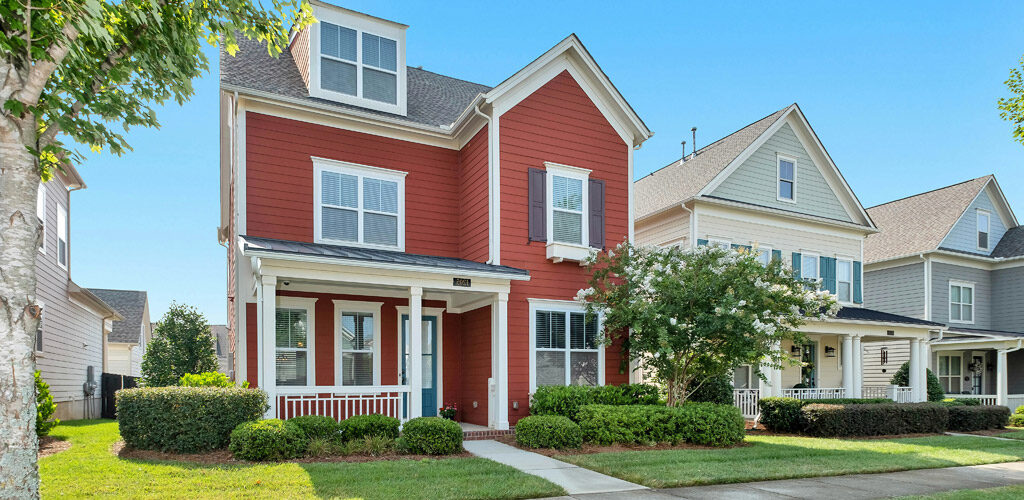How Often Should You Paint Your House Exterior in Southern Oregon?
Key Takeaways
- How often different exterior surfaces – wood siding, fiber cement, stucco, painted brick, trim, and windows – typically need repainting.
- The impact Southern Oregon’s hot summers, wet winters, and sun exposure have on paint life, and when it starts to fail.
- The early signs that let you know it’s time to repaint – fade, peeling, exposed wood, or aging caulk.
- What preparation helps paint jobs last longer, and how a quality job saves you money in the long run.
Exterior paint does more than give your home a fresh look – it’s the first line of defense against weather, sun, and moisture. Over time, even the highest-quality paint wears down. Knowing when to repaint keeps your home protected and beautiful. Here’s an easy-to-follow guide that outlines just how often you should paint your house.
Why Regular Painting Matters
A professional paint job creates a protective barrier that shields siding, trim, and other surfaces from the elements. When paint fails, water seeps in, wood rots, and repairs become expensive. Routine repainting:
- Blocks Moisture: Prevents rain and snow from penetrating siding and trim.
- Guards Against Sun Damage: UV rays fade colors and break down paint binders.
- Preserves Property Value: A well-maintained exterior boosts curb appeal and resale price.
How Often You Should Paint Various House Materials
Every surface has its own maintenance cycle. These ranges assume quality paint and proper preparation:
Wood Siding
Every 5–7 years. Wood expands and contracts with temperature swings, making it prone to peeling.
Fiber Cement (Hardie Board)
Every 8–12 years, when painted with high-quality acrylic.
Stucco
Every 5–10 years, with regular crack inspection and repair.
Brick (Painted)
Every 12–15 years, though occasional touch-ups help maintain color.
Trim, Doors, and Windows
Often need attention sooner—around 3–5 years—because they take more weather exposure.
Local Factors That Influence Timing
Southern Oregon’s climate makes a difference.
- Hot, Sunny Summers: Strong UV rays accelerate fading and break down the paint film, especially on south- and west-facing sides.
- Wet Winters: Moisture and freeze-thaw cycles cause peeling, blistering, and mildew, particularly in shaded areas.
- Tree Cover & Landscaping: Overhanging branches hold moisture against siding and can shorten the life of your paint.
- Wind Exposure: Wind-driven rain wears away protective coatings more quickly.
Signs It’s Time to Repaint Your House
You don’t have to wait for the calendar if you notice these red flags:
- Peeling or Cracking: Visible paint failure exposes bare wood to the elements.
- Fading or Chalky Color: A dusty, chalk-like residue signals UV breakdown.
- Exposed Wood or Bare Spots: Water intrusion and rot can follow quickly.
- Open Caulk Joints: Gaps around windows, doors, and trim invite moisture.
Preparation Is Key
Longevity starts before the first brushstroke. A professional painter will:
- Wash the Surface: Remove dirt, mildew, and chalking with a gentle pressure wash.
- Scrape & Sand: Eliminate loose or peeling paint.
- Repair & Caulk: Seal gaps and fix minor siding or trim damage.
- Prime Bare Wood: Ensures strong adhesion and even color.
Cutting corners in prep is the most common reason a paint job fails early.
Professional vs. DIY
Painting a single-story shed might be a weekend project, but painting an entire house is another matter. Professionals bring:
- Specialized Tools & Safety Gear: Ladders, sprayers, and harnesses for multi-story work.
- Product Knowledge: The right paint and primer for each surface.
- Climate Expertise: Strategies to combat sun fade and handle wet-weather challenges.
A professional job lasts longer and often costs less over time by reducing the need for frequent repainting.
How Pacific Home Painting Helps
At Pacific Home Painting, we handle every step of exterior painting, from cleaning and repairs to priming and final coats. We understand Southern Oregon’s hot summers and wet winters, so we select premium paints and finishes that withstand the local climate. We also offer:
- Flexible scheduling for homeowners, property managers, and HOAs.
- Expert color consultations to combat sun fading. (picking the right color matters!)
- Free, no-obligation inspections and estimates. (click for a free quote)
Tips to Extend the Life of Your Paint Job
- Annual Gentle Washing: Remove dirt and mildew to prevent premature breakdown.
- Trim Shrubs and Trees: Reduce moisture contact and allow airflow.
- Touch Up Early: Address chips, caulk gaps, or small cracks before they spread.
- Monitor Sun-Facing Walls: South and west sides may need touch-ups sooner.
Keep Your Home Protected and Beautiful
Regular painting is a smart investment. For most homes, that means a full repaint every 5–10 years is how often you should paint, depending on siding type and exposure. Watch for signs of wear, and don’t wait until peeling or rot sets in.
Ready to refresh your home’s exterior? Contact Pacific Home Painting for a free inspection and estimate. We’ll recommend the best timing and products to keep your house looking its best year-round.
FAQs
Wood siding typically needs new paint every 5–7 years, fiber-cement every 8–12 years, stucco every 5–10 years, and painted brick about 12–15 years, depending on climate and sun exposure.
Southern Oregon’s intense summer sun, wet winters, and areas with heavy shade or wind can cause paint to fade, peel, or crack sooner.
Look for peeling, bubbling, fading or chalky color, exposed wood, or caulk pulling away around trim and windows.
Yes. High-quality exterior paints last longer, resist fading, and provide better protection against moisture and UV rays, extending the time between repaints.
Gentle yearly washing, trimming back plants, and touching up small chips or cracks can help a professional paint job last several years longer.
